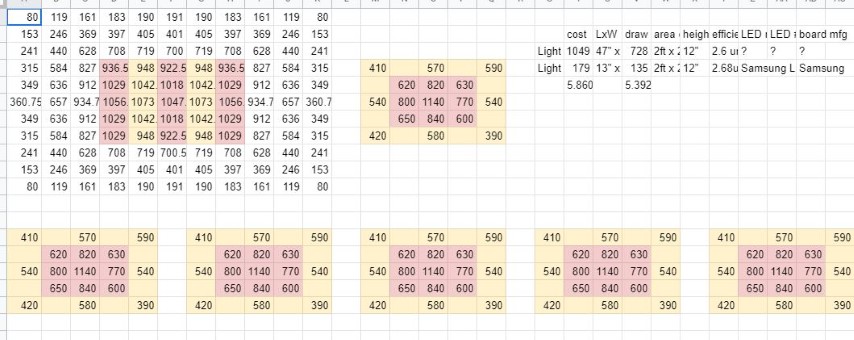


The point of this quick post is to highlight recent reductions (~15yrs max) in the cost of light for the home grower. For a much cooler, much longer term read I highly recommend reading - or at least skimming, the famous William Nordhaus study.
I posit that the two most important recent changes were:
** This statement applies to any of the “approaching 90+ CRI” diodes coming online around this time - some of which have since proven not to “drop-off” when being driven harder (conceptually similar to overlocking) the way the lm-301x diodes are sometimes observed to.
Home grow light marketing is awash with misinformation (ie, “perfect spectrum” or “wattage equivalent”); the DIY crowds tend to be good sources for digesting new product releases due to their rapid adoption (subject to diode availability). For this group the 2010s to current acceptance of “best” grow light has gone: “blurple” -> “COB” -> “Quantum Board.” Reasons frequently cited for this shift include: deceptive marketing of power draw “at the fixture,” changes to understanding of how plants absorb light, and the availability of high efficiency diodes - namely Samsung’s.
Generalizing: When something that looks white is listed as “3500K,” the 3500k is actually an approximation for how the combination of different wavelengths produced by the light source appears. This is complicated to calculate and is beyond our purpose (and my abilities).
In the light fixture market wide-spectrum usually refers to the Kelvin temperature approximation of a singly-packaged diode that contains more than one diode inside the package and produces multiple wavelengths. This is a similar concept to a COB but not necessarily the same - it doesn’t mean the diodes are mounted to silicon within the package.
There are a lot of absolute claims re: spectrum, and unfortunately like any known-unknown it’s where a lot of disinformation lies. Some fixture manufacturers misuse the already-subjective term “full-spectrum” with an approximated Kelvin temperature for a combination of single-wavelength diodes. This is generally frowned upon by the market and not present in serious offerings. Typically all manufacturers offer a chart showing the specific wavelength output of their fixture similar to the below:
Lights comprised primarily of far-red and blue diodes (they look purple) were originally thought to provide plants all they need. The resulting sankey-esque assumption was energy for wavelengths outside of the “photosynthesis” and “growth” ranges was wasted energy…this is no longer considered accurate. The example I chose is from an LED trade magazine, but one can easily search google scholar or scrape data from any large online forum (reddit / pushshift) and come to the same conclusion by comparing blurple and wide-spectrum results: although the green /”middle” spectrum is likely least understood in photobiology, it’s definitely doing something:
Technical advances in LED diodes have led to “full-spectrum” or “multi-spectrum” lights that are still heavily-composed of far-red and blue diodes leading to a pinkish hue. OSRAM is big here, and the fixtures are still semi-popular / marketed today. They are not always seen as a serious contender for growers - especially those alternating crops. Some companies offer programmability to overcome this.
COB stands for Chip On Board, a reference to the diodes being mounted directly to a semiconductor. More accurately, COBs are an array of many diodes tightly packed and bonded on a (usually silicon) board. These fixtures are BRIGHT, and were brighter than anything on the market upon release. When arranged in an array over a growing area - despite their usually-higher power draw, they can be more efficient than blurples. They also kick off less heat, something that keeps coming up as a problem for growers at scale (but shouldn’t - more on that another time). Notably, COBs are “full” or “wide” spectrum when measured in Kelvin.
A Quantum Board (QB) is a trade name from Horticulture Lighting Group. The fixture can be seen as an evolution of the COB. A QB still uses diodes mounted in silicon - however instead of many packed tight and bundled into a single fixture, a QB uses less-dense, mid-powered diodes and spreads 288 of them over a large single silicon board:
The result is a higher PPFD on average. The efficiency of this array pattern is visible in this poorly-scaled excel chart …one could buy 5 quantum boards for less than one of the first light, pay less than 1/5 the electricity per board, and cover the same area with much higher PPFD and 4 “squares” to spare.
This is both in part to the shifting of the array concept to something more akin to a matrix - and certainly helped by the use of more efficient mid-power diodes. They’ve been updated to include far-red and blue (in small amounts, separately), and to use the newest diodes. Although they remain among the more expensive, in 2021 there are a number of bar-shaped competitors employing a similar approach online with comparable results. The key in the fixture game is looking for independent lab results. The funky sphere used to test is required for luminous flux results and is usually something a lab owns.
One standout from 2020 is that Samsung has begun making the silicon boards for HLG. I am not aware of what that actually means but perception online is that it would ensure best mounting, best flux-binned diodes (which the LMH should already be), etc.
The First 2016 QB288v1 usedSamsung LM561C diodes which have been variously tested up to ~2.5 μmol/j. Current boards use the LM301H which has been widely-tested by a variety of labs at a high as ~3.1 μmol/j. This is compared to ~1.0 in the late-aughts.
Similar to the spectrum charts of fixture side, diode manufacturers often make available their design files and technical specifications. This is currently the pound for pound winner in the diode game.